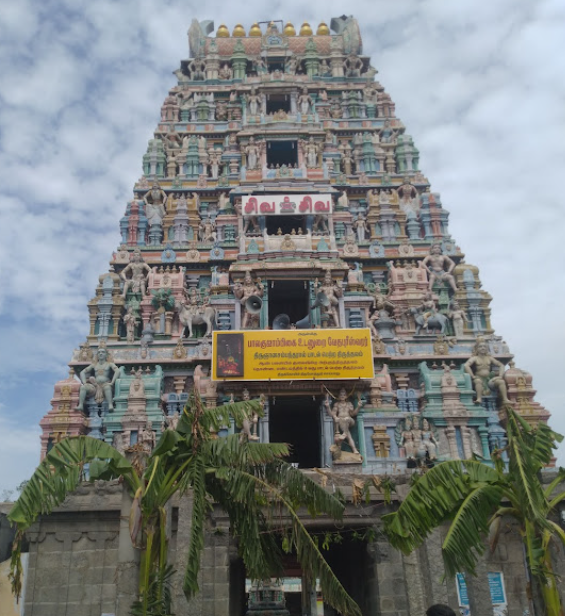Origin/History :-
The Vedapureeswarar Temple, located in the town of Cheyyar (formerly known as Thiruvothur) in Tamil Nadu, is a significant and ancient temple dedicated to Lord Shiva. It is one of the 275 Paadal Petra Sthalams, revered in the hymns of the Tamil Shaivite saints, including Thirugnanasambandar. The temple is historically notable for its association with the Vedas, as Lord Shiva is worshipped here as Vedapureeswarar, the one who imparts knowledge of the Vedas.
The origin of the temple is linked to several legendary events. According to local lore, Lord Shiva imparted the knowledge of the Vedas to his devotees at this location. It is believed that Saint Thirugnanasambandar performed miracles here, including transforming a male palm tree into a female palm tree, showcasing his divine powers. Additionally, it is said that Arunagirinathar, the famous poet-saint devoted to Lord Muruga, also worshipped in this temple.
Inscriptions from various kings, including Rajathirajan, Kulothunga Chozha, Rajaraja, and others, reveal the temple's historical importance. These inscriptions describe the donations, endowments, and land grants given to the temple over the centuries. The temple has witnessed significant patronage from several Chola and Pandya rulers, as indicated by the inscriptions, which mention land donations for perpetual lamps, religious offerings, and the creation of gardens within the temple precincts.
The temple's earlier name, Thiruvothur, signifies its ancient heritage, with the place being historically known as Jayangonda Chozamandalathu Kazhiyur nattu Thiruvothur in the inscriptions. The sacred space of this temple has drawn worshippers over the centuries, owing to its association with powerful divine events, royal patronage, and its central role in the spiritual life of the region.
Puranic Significance :-
According to Hindu mythology, Dakshayani, the daughter of Dakshan and granddaughter of Lord Brahma, was married to Lord Shiva. Once, Dakshan performed a grand yagna but intentionally did not invite Lord Shiva, which greatly offended Dakshayani. Determined to resolve the matter, Dakshayani decided to visit the yagna, against her husband’s wishes, to request her father to invite Lord Shiva. However, overwhelmed by his arrogance and pride, Dakshan humiliated both Dakshayani and Lord Shiva. Enraged by this insult, Dakshayani cursed her father, declaring that his yagna would not be successful. In addition, feeling the need to atone for the sin of being the daughter of an enemy of Lord Shiva, she chose to perform penance at this sacred place, which is now known as Thiruvothur.
- Thirugnana Sambandar and the Conversion of Male Palm Trees to Female Palm Trees:
During the period of the Nayanmars, the temple was frequently affected by floods from the Cheyyar River, as it was situated along the riverbank. A devotee of Lord Shiva, who took care of the temple, raised the riverbanks and planted palm trees to prevent flooding. However, all the palm trees planted were male and did not bear fruit. The local Jains mocked the devotee, saying that Lord Shiva’s power could not even transform male palm trees into fruit-bearing female trees. They challenged him to convert to Shaivism if Lord Shiva could perform such a miracle.
When Thirugnana Sambandar visited the temple, the devotee shared the challenge made by the Jains. Thirugnana Sambandar responded by singing a Thevara Pathigam. Miraculously, all the male palm trees were transformed into female fruit-bearing trees, by the grace of Lord Shiva. Witnessing this miracle, the Jains of the area converted to Shaivism. In memory of this event, a stone palm tree can be seen in front of the goddess Parvati shrine, and five fruit-bearing palm trees in the temple’s prakaram are believed to be descendants of the transformed trees.
- Nagalingam:
When Thirugnana Sambandar visited Thiruvothur, the Jains attempted to kill him by sending a poisonous snake. However, Thirugnana Sambandar redirected the snake back to the Jain leader. Realizing the power of the saint, the Jain leader surrendered. Sambandar then prayed to Lord Shiva, who appeared as a snake charmer and took the snake away. An idol of Nagalingam (Naganathar) in the temple commemorates this event.
- Cheyyatril Vendran:
In another legend, the Jains invited Thirugnana Sambandar for a contest. They threw a Jain manuscript into the Cheyyar River, hoping it would be lost. However, when Sambandar threw the Shaivite manuscript, it returned to the shore unharmed. The spot where the manuscript reached the shore is called Cheyyatril Vendran. This event led the Jains to acknowledge their defeat.
- Nandi Facing Outside:
King Thondaiman of the region, a devout follower of Lord Vedapuriswarar, once faced defeat at the hands of King Visvavasu. Despondent, Thondaiman prayed to Lord Shiva for victory. Pleased with his devotion, Lord Shiva instructed Nandi to assist Thondaiman in battle. Nandi helped Thondaiman win the war. In commemoration of this, Nandi faces outside, symbolizing his readiness to accompany the king. Another version of the legend suggests that Nandi faced outside to guard the entrance while Lord Shiva taught the Vedas to the devas and sages, allowing only them to enter.
- Vedapureeswarar:
Lord Shiva is believed to have imparted the Vedas to the devas and sages at this place, which is why he is called Vedapureeswarar. The location became known as Thiru Vedapuram, Thiru Odhu Puram, Thiruvettipuram, and Thiruvothur.
Lord Murugan Worshipped Lord Shiva Here:
This temple is considered one of the places where Lord Murugan is believed to have worshipped Lord Shiva. It is also believed that the Cheyyar River was created by Lord Murugan.
- Cheyyaru:
Legend states that Goddess Parvati, using her trident (Trisula), drew a line on the earth to create a river for her son, Lord Murugan, to play in. This river came to be called Cheyyaru, with “Sei” meaning son and “Aaru” meaning river.
- People Worshipped Lord Shiva Here:
It is believed that many revered figures, including Lord Murugan, Lord Vinayaga, Lord Bhairava, Goddess Dakshayani, Lord Vishnu, Lord Brahma, Lord Surya, King Thondaiman, Thirugnana Sambandar, Appar, and the devas and sages, all worshipped Lord Shiva at this temple.
